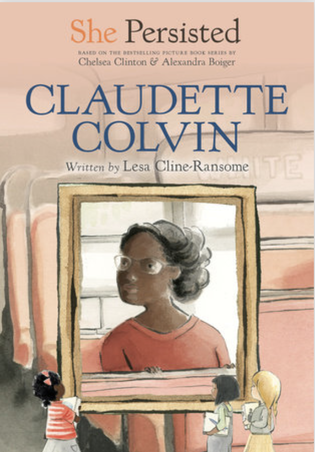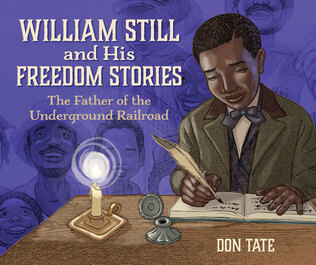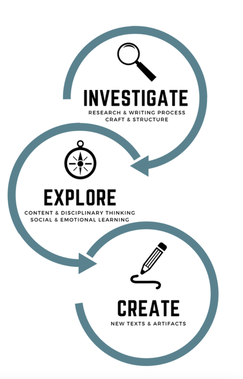BY JENNIFER SANDERS & COURTNEY SHIMEK, ON BEHALF OF THE BIOGRAPHY CLEARINGHOUSE  Many people have heard of Rosa Parks’ role in the Montgomery Bus Boycott, but few know that Claudette Colvin resisted bus segregation months before. Lesa Cline-Ransome’s new biography, She Persisted: Claudette Colvin, published by Penguin Random House, highlights 15 year-old Claudette’s role in the civil rights movement of the 1950s. Influenced by her teachers’ lessons on Black history, Claudette was armed with the courage of knowledge when she defied a bus driver’s order to move for a white passenger. When Claudette recalled that moment, she said, “Harriet Tubman’s hands were pushing down on one shoulder and Sojourner Truth’s hands were pushing down on the other shoulder… I couldn’t move” (Cline-Ransome, 2021, p.26). Claudette’s frustration about the injustices she witnessed in her life, including the loss of her younger sister to polio, spurred her actions that brought “the revolution to Montgomery” (2021, p.31). Cline-Ransome highlights these frustrations and mirrors Claudette’s curious, inquisitive nature by employing a question and answer secondary text structure throughout the biography. Cline-Ransome’s transitional chapter book about Claudette Colvin is currently featured on The Biography Clearinghouse . The crafted teaching guide includes information about three other women who resisted segregated bus policies before Rosa Parks and took the fight to federal court in the 1956 case Browder vs. Gayle. This book debunks historical myths and tells a fuller, more inclusive history of the individual and collective actions of people of color fighting oppression. Two of the plaintiffs in that court case were teenagers: Claudette Colvin was 15, and Mary Louise Smith was 18. In our interview, Lesa Cline-Ransome noted the connection between these young women’s activism and today’s young people serving as leaders of environmental and civil rights movements. This book can serve as a springboard for exploring present-day youth social activism with students. Operating within the Investigate, Explore, and Create Model of the Biography Clearinghouse, we designed teaching ideas to accompany She Persisted: Claudette Colvin.
Create |
If you have 1-2 hours... |
If you have 1-2 days... |
If you have 1-2 weeks... |
After reading She Persisted: Claudette Colvin, have students do a quick write about the Montgomery Bus Boycott. Ask them to generate questions they still have about the movement or these events in history. As a whole group, create an anchor chart of students’ questions. |
Jigsaw: Group 1: Put students into 4-6 groups (group A, B, C, etc.) and have them select one text from the set above. Give each group time to read their text, select important information, and look for answers to their personal questions (from the 1-2 hours activity). Group 2: Regroup the students with one person from each original group in each new group (i.e., one student from A, B, and C, etc.). Each student shares what they learned from the text they read with their first group. Have each group select one question they want to explore about the event and try to answer during this group share. Debrief with the whole class about what they learned. |
Using Cline-Ransome’s writing as a mentor, create a shared book that includes questions students asked and answers they found during the jigsaw. Students can title each chapter with the question, like Cline-Ransome did in She Persisted: Claudette Colvin, and have students answer that question in that section. “Publish” this book and display it for visitors to read and/or place in your classroom library. |
|
To see more classroom possibilities and helpful resources connected to She Persisted: Claudete Colvin, visit our Book Entry at The Biography Clearinghouse. Additionally, we’d love to hear how the interview and these ideas inspired you. Email us at [email protected] with your connections, creations, questions. Citation
Kristo, J. V., & Bamford, R. A. (2004). Nonfiction in focus: A comprehensive framework for helping students become independent readers and writers of nonfiction, K-6. Scholastic Professional Books.
|
Courtney Shimek is an Assistant Professor in the department of Curriculum & Instruction/Literacy Studies at West Virginia University. She has been a CLA member since 2015.
BY AMINA CHAUDHRI AND MARY ANN CAPPIELLO, ON BEHALF OF THE BIOGRAPHY CLEARINGHOUSE
and the stories he preserved,
reunited families
torn apart by slavery.
Because that’s what stories can do.
Protest injustice.
Sooth. Teach. Inspire. Connect.
Stories save lives.”
- Don Tate, from William Still and His Freedom Stories: The Father of the Underground Railroad

Don Tate’s picturebook biography William Still and His Freedom Stories: The Father of the Underground Railroad, this month’s featured text on The Biography Clearinghouse, is an important text to help make this change in elementary and middle school classrooms. William Still and his Freedom Stories is one of several recent publications that highlights the role of African Americans in the freedom struggle, countering the narrative that freedom from slavery depended on the actions of whites.
A precise, linear narrative takes readers through significant events that shaped William Still’s understanding of the world and his role in making it better for African Americans. Readers follow Still from childhood to adulthood, bearing witness to his desire to learn, the grueling labor he endured to earn a living, and eventually, the risks he took to secure freedom for enslaved people and his post-Civil War activism to fight segregation. This deeply-researched and powerfully-illustrated book has layers of curricular potential: as a read aloud, as a mentor text for literacy skill development, as a model of the genre of biography, as an important piece of history, and much more.
Operating within the Investigate, Explore, and Create Model of the Biography Clearinghouse, we designed teaching ideas geared toward literacy and content area learning as well as opportunities for socio-emotional learning and strengthening community connections using William Still and His Freedom Stories.
Featured here are two teaching ideas inspired by William Still and His Freedom Stories. The first engages students deeply with the text itself - its form and content, and the second extends learning beyond this picturebook to explore multiple sources for inquiry and research.
William Still and his Freedom Stories as a Mentor Text for Close Reading, Writing, and Research.
Don Tate, like William Still, understands the importance of word choice and organization of ideas in writing. William Still and his Freedom Stories can be used as a mentor text to teach these literacy concepts. The brevity of the picturebook lends itself well to repeated readings and analysis of the precise language Tate employs to convey his message. A writer’s message is effective if it evokes a response in the reader. The suggestions below invite students to reflect deeply on the text and their own responses in the process of making meaning.
|
From the Biography Clearinghouse
|
If you have 1-2 hours…. |
If you have 1-2 days… |
If you have 1-2 weeks…. |
Teachers model the Double Entry Journal strategy for responding to text with a focus on text analysis/close reading using a selection of quotes from William Still and his Freedom Stories:
|
William Still’s writing was a form of activism because it contributed to the work of changing people’s lives and resisting a brutal system. Compare and contrast this form of activism with the work done by other historical and contemporary figures in other biographies. A graphic organizer such as a T Chart can help students organize their observations. Next, following a discussion, students can identify the skills and talents these subjects brought to their work. Finally, they can extend their thinking by listing other ways people can use their skills (such as in art, music, sports etc.) in order to build awareness and create change. This list can lead to inquiry projects. |
When students have understood the concept of turning points as life-altering experiences, and as literary devices that authors use to further their ideas, they can synthesize their learning within the context of studying biographies. One project could be to create a biography of someone in their community with specific requirements including elements found in William Still and his Freedom Stories. These include but are not limited to: childhood, youth, and adult phases of life; ideas and/or people who were influential; and 2-3 turning points that were particularly salient in the person’s life. If possible, the student could research the person’s context in order to understand the various factors that inform decisions and actions. The project can be taken through all the stages of the writing process and completed in pairs or groups. Final projects could be written, illustrated, recorded, dramatized or created in any way that suits the form and content. |
Advocating for and Learning from 19th Century Black-Authored Texts
If you have 1-2 hours…. |
If you have 1-2 days… |
If you have 1-2 weeks…. |
After reading William Still and His Freedom Stories, provide students with the opportunity to read pages from Journal C of the Underground Railroad. Support students as you examine the information, as this material is painful to read. What kinds of information did Still document to help reunite loved ones? What are some connections students are able to make across the journal? How were those fleeing slavery similar to one another? How were their circumstances different from one another? |
After exploring Still’s own writing, have students consider his personal path to literacy. How might his writing voice and identity have been shaped by the texts that he read? In the narrative, Don Tate notes that Still read The Colored American. “An “anti-slavery newspaper,/it was owned and published by Black people.” Share this description of the newspaper with students. Next, have students spend some time reading through digital copies of The Colored American from The Center for Research Libraries. What do they notice about the information in the newspaper? Have students take notes on what they are learning about the lives of free and enslaved Blacks at the time of the newspaper’s publication. |
The Historical Society of Pennsylvania has created a prototype of a digital database, the “Family Ties on the Underground Railroad” project, that connects information from Journal C with Still’s 1872 book The Underground Rail Road. You and your students can access the prototype with the codes available on the landing page. Provide students with time to explore the prototype and see the ways in which it uses information from the two texts and allows us to learn more about Black individuals and communities “geographically and chronologically.” Students can learn more about the process of putting the prototype together via the blog entries available on the right margin of the site. Next, you might partner with your local historical society to see what you can learn about Black history in your area from the texts and artifacts from the collection. How can your students raise awareness of that history? What new texts can they create in response to their learning? Allow students to make those choices and determine a way to share their texts with your local community. You could also inform students of the Pennsylvania Historical Society’s efforts to raise money to expand the digital “Family Ties on the Underground Railroad” project. Have students brainstorm ways to raise both awareness and funding for this important project and then carry them out, using their literacy skills as a force for good like William Still. |
Mary Ann Cappiello teaches courses in children’s literature and literacy methods at Lesley University, blogs about teaching with children’s literature at The Classroom Bookshelf, a School Library Journal blog, and is a former chair of NCTE’s Orbis Pictus Award for Outstanding Nonfiction K-8.
Authors:
CLA Members
Supporting PreK-12 and university teachers as they share children’s literature with their students in all classroom contexts.
The opinions and ideas posted in the individual entries are those of the individual authors and do not necessarily reflect the opinions or views of CLA or the Blog Editors.
Blog Editors
contribute to the blog
If you are a current CLA member and you would like to contribute a post to the CLA Blog, please read the Instructions to Authors and email co-editor Liz Thackeray Nelson with your idea.
Archives
May 2024
April 2024
March 2024
February 2024
January 2024
December 2023
November 2023
October 2023
September 2023
August 2023
May 2023
April 2023
March 2023
December 2022
November 2022
October 2022
September 2022
August 2022
June 2022
May 2022
April 2022
March 2022
February 2022
January 2022
December 2021
November 2021
October 2021
September 2021
August 2021
June 2021
May 2021
April 2021
March 2021
February 2021
January 2021
December 2020
November 2020
October 2020
September 2020
August 2020
June 2020
May 2020
April 2020
March 2020
Categories
All
Activism
Advocacy
African American Literature
Agency
All Grades
American Indian
Antiracism
Art
Asian American
Authors
Award Books
Awards
Back To School
Barbara Kiefer
Biography
Black Culture
Black Freedom Movement
Bonnie Campbell Hill Award
Book Bans
Book Challenges
Book Discussion Guides
Censorship
Chapter Books
Children's Literature
Civil Rights Movement
CLA Auction
CLA Breakfast
CLA Expert Class
Classroom Ideas
Collaboration
Comprehension Strategies
Contemporary Realistic Fiction
COVID
Creativity
Creativity Sponsors
Critical Literacy
Crossover Literature
Cultural Relevance
Culture
Current Events
Digital Literacy
Disciplinary Literacy
Distance Learning
Diverse Books
Diversity
Early Chapter Books
Emergent Bilinguals
Endowment
Family Literacy
First Week Books
First Week Of School
Garden
Global Children’s And Adolescent Literature
Global Children’s And Adolescent Literature
Global Literature
Graduate
Graduate School
Graphic Novel
High School
Historical Fiction
Holocaust
Identity
Illustrators
Indigenous
Indigenous Stories
Innovators
Intercultural Understanding
Intermediate Grades
International Children's Literature
Journal Of Children's Literature
Language Arts
Language Learners
LCBTQ+ Books
Librarians
Literacy Leadership
#MeToo Movement
Middle Grade Literature
Middle Grades
Middle School
Mindfulness
Multiliteracies
Museum
Native Americans
Nature
NCBLA List
NCTE
NCTE 2023
Neurodiversity
Nonfiction Books
Notables
Nurturing Lifelong Readers
Outside
#OwnVoices
Picturebooks
Picture Books
Poetic Picturebooks
Poetry
Preschool
Primary Grades
Primary Sources
Professional Resources
Reading Engagement
Research
Science
Science Fiction
Self-selected Texts
Small Publishers And Imprints
Social Justice
Social Media
Social Studies
Sports Books
STEAM
STEM
Storytelling
Summer Camps
Summer Programs
Teacher
Teaching Reading
Teaching Resources
Teaching Writing
Text Sets
The Arts
Tradition
Translanguaging
Trauma
Tribute
Ukraine
Undergraduate
Using Technology
Verse Novels
Virtual Library
Vivian Yenika-Agbaw Student Conference Grant
Vocabulary
War
#WeNeedDiverseBooks
YA Lit
Young Adult Literature



 RSS Feed
RSS Feed